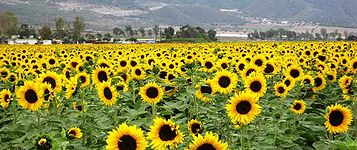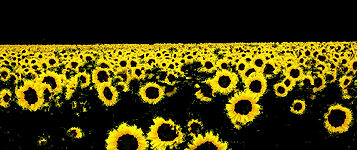Difference between revisions of "Example Color Segmentation"
From BoofCV
Jump to navigationJump to search (Updated for v0.16) |
m |
||
| (11 intermediate revisions by the same user not shown) | |||
| Line 6: | Line 6: | ||
</center> | </center> | ||
Demonstration for how an image can be segmented using color information. | Demonstration for how an image can be segmented using color information. First the image is converted into HSV color space to add robustness against changes in lighting. Then the user selects a color and it selects pixels with a hue and saturation value and display the resulting image. | ||
Example File: [https://github.com/lessthanoptimal/BoofCV/blob/v0. | Example File: [https://github.com/lessthanoptimal/BoofCV/blob/v0.40/examples/src/main/java/boofcv/examples/segmentation/ExampleSegmentColor.java ExampleSegmentColor.java] | ||
Concepts: | Concepts: | ||
| Line 16: | Line 16: | ||
Related Examples: | Related Examples: | ||
* [[Example_Color_Space| Color Space]] | * [[Example_Color_Space| Color Space]] | ||
* [[Example_Watershed_with_Seeds| Watershed with Seeds]] | |||
* [[Example_Image_Segmentation| Image Segmentation]] | |||
= Example Code = | = Example Code = | ||
<syntaxhighlight lang="java"> | <syntaxhighlight lang="java"> | ||
/** | /** | ||
* Example which demonstrates how color can be used to segment an image. | * Example which demonstrates how color can be used to segment an image. The color space is converted from RGB into | ||
* HSV. | * HSV. HSV separates intensity from color and allows you to search for a specific color based on two values | ||
* independent of lighting conditions. | * independent of lighting conditions. Other color spaces are supported, such as YUV, XYZ, and LAB. | ||
* | * | ||
* @author Peter Abeles | * @author Peter Abeles | ||
*/ | */ | ||
public class ExampleSegmentColor { | public class ExampleSegmentColor { | ||
/** | /** | ||
* Shows a color image and allows the user to select a pixel, convert it to HSV, print | * Shows a color image and allows the user to select a pixel, convert it to HSV, print | ||
| Line 33: | Line 34: | ||
*/ | */ | ||
public static void printClickedColor( final BufferedImage image ) { | public static void printClickedColor( final BufferedImage image ) { | ||
var gui = new ImagePanel(image); | |||
gui.addMouseListener(new MouseAdapter() { | gui.addMouseListener(new MouseAdapter() { | ||
@Override | @Override | ||
public void mouseClicked(MouseEvent e) { | public void mouseClicked( MouseEvent e ) { | ||
float[] color = new float[3]; | float[] color = new float[3]; | ||
int rgb = image.getRGB(e.getX(),e.getY()); | int rgb = image.getRGB(e.getX(), e.getY()); | ||
ColorHsv.rgbToHsv((rgb >> 16) & 0xFF,(rgb >> 8) & 0xFF , rgb&0xFF,color); | ColorHsv.rgbToHsv((rgb >> 16) & 0xFF, (rgb >> 8) & 0xFF, rgb & 0xFF, color); | ||
System.out.println(" | System.out.println("H = " + color[0] + " S = " + color[1] + " V = " + color[2]); | ||
showSelectedColor("Selected",image, | showSelectedColor("Selected", image, color[0], color[1]); | ||
} | } | ||
}); | }); | ||
ShowImages.showWindow(gui, "Color Selector"); | |||
ShowImages.showWindow(gui,"Color Selector"); | |||
} | } | ||
/** | /** | ||
* Selectively displays only pixels which have a similar hue and saturation values to what is provided. | * Selectively displays only pixels which have a similar hue and saturation values to what is provided. | ||
* This is intended to be a simple example of color based segmentation. | * This is intended to be a simple example of color based segmentation. Color based segmentation can be done | ||
* in RGB color, but is more problematic. | * in RGB color, but is more problematic due to it not being intensity invariant. More robust techniques | ||
* can use Gaussian models instead of a uniform distribution, as is done below. | |||
*/ | */ | ||
public static void showSelectedColor( String name , BufferedImage image , float hue , float saturation ) { | public static void showSelectedColor( String name, BufferedImage image, float hue, float saturation ) { | ||
Planar<GrayF32> input = ConvertBufferedImage.convertFromPlanar(image, null, true, GrayF32.class); | |||
Planar<GrayF32> hsv = input.createSameShape(); | |||
// Convert into HSV | // Convert into HSV | ||
ColorHsv. | ColorHsv.rgbToHsv(input, hsv); | ||
// | // Euclidean distance squared threshold for deciding which pixels are members of the selected set | ||
float maxDist2 = 0.4f*0.4f; | float maxDist2 = 0.4f*0.4f; | ||
// Extract hue and saturation bands which are independent of intensity | // Extract hue and saturation bands which are independent of intensity | ||
GrayF32 H = hsv.getBand(0); | |||
GrayF32 S = hsv.getBand(1); | |||
// Adjust the relative importance of Hue and Saturation | // Adjust the relative importance of Hue and Saturation. | ||
// Hue has a range of 0 to 2*PI and Saturation from 0 to 1. | |||
float adjustUnits = (float)(Math.PI/2.0); | float adjustUnits = (float)(Math.PI/2.0); | ||
// step through each pixel and mark how close it is to the selected color | // step through each pixel and mark how close it is to the selected color | ||
var output = new BufferedImage(input.width, input.height, BufferedImage.TYPE_INT_RGB); | |||
for( int y = 0; y < hsv.height; y++ ) { | for (int y = 0; y < hsv.height; y++) { | ||
for( int x = 0; x < hsv.width; x++ ) { | for (int x = 0; x < hsv.width; x++) { | ||
// | // Hue is an angle in radians, so simple subtraction doesn't work | ||
float dh = UtilAngle.dist(H.unsafe_get(x,y),hue); | float dh = UtilAngle.dist(H.unsafe_get(x, y), hue); | ||
float ds = (S.unsafe_get(x,y)-saturation)*adjustUnits; | float ds = (S.unsafe_get(x, y) - saturation)*adjustUnits; | ||
// this distance measure is a bit naive, but good enough for | // this distance measure is a bit naive, but good enough for to demonstrate the concept | ||
float dist2 = dh*dh + ds*ds; | float dist2 = dh*dh + ds*ds; | ||
if( dist2 <= maxDist2 ) { | if (dist2 <= maxDist2) { | ||
output.setRGB(x,y,image.getRGB(x,y)); | output.setRGB(x, y, image.getRGB(x, y)); | ||
} | } | ||
} | } | ||
} | } | ||
ShowImages.showWindow(output,"Showing "+name); | ShowImages.showWindow(output, "Showing " + name); | ||
} | } | ||
public static void main( String | public static void main( String[] args ) { | ||
BufferedImage image = UtilImageIO. | BufferedImage image = UtilImageIO.loadImageNotNull(UtilIO.pathExample("sunflowers.jpg")); | ||
// Let the user select a color | // Let the user select a color | ||
printClickedColor(image); | printClickedColor(image); | ||
// Display pre-selected colors | // Display pre-selected colors | ||
showSelectedColor("Yellow",image,1f,1f); | showSelectedColor("Yellow", image, 1f, 1f); | ||
showSelectedColor("Green",image,1.5f,0.65f); | showSelectedColor("Green", image, 1.5f, 0.65f); | ||
} | } | ||
} | } | ||
</syntaxhighlight> | </syntaxhighlight> | ||
Latest revision as of 15:25, 17 January 2022
Demonstration for how an image can be segmented using color information. First the image is converted into HSV color space to add robustness against changes in lighting. Then the user selects a color and it selects pixels with a hue and saturation value and display the resulting image.
Example File: ExampleSegmentColor.java
Concepts:
- Color space
- Image segmentation
Related Examples:
Example Code
/**
* Example which demonstrates how color can be used to segment an image. The color space is converted from RGB into
* HSV. HSV separates intensity from color and allows you to search for a specific color based on two values
* independent of lighting conditions. Other color spaces are supported, such as YUV, XYZ, and LAB.
*
* @author Peter Abeles
*/
public class ExampleSegmentColor {
/**
* Shows a color image and allows the user to select a pixel, convert it to HSV, print
* the HSV values, and calls the function below to display similar pixels.
*/
public static void printClickedColor( final BufferedImage image ) {
var gui = new ImagePanel(image);
gui.addMouseListener(new MouseAdapter() {
@Override
public void mouseClicked( MouseEvent e ) {
float[] color = new float[3];
int rgb = image.getRGB(e.getX(), e.getY());
ColorHsv.rgbToHsv((rgb >> 16) & 0xFF, (rgb >> 8) & 0xFF, rgb & 0xFF, color);
System.out.println("H = " + color[0] + " S = " + color[1] + " V = " + color[2]);
showSelectedColor("Selected", image, color[0], color[1]);
}
});
ShowImages.showWindow(gui, "Color Selector");
}
/**
* Selectively displays only pixels which have a similar hue and saturation values to what is provided.
* This is intended to be a simple example of color based segmentation. Color based segmentation can be done
* in RGB color, but is more problematic due to it not being intensity invariant. More robust techniques
* can use Gaussian models instead of a uniform distribution, as is done below.
*/
public static void showSelectedColor( String name, BufferedImage image, float hue, float saturation ) {
Planar<GrayF32> input = ConvertBufferedImage.convertFromPlanar(image, null, true, GrayF32.class);
Planar<GrayF32> hsv = input.createSameShape();
// Convert into HSV
ColorHsv.rgbToHsv(input, hsv);
// Euclidean distance squared threshold for deciding which pixels are members of the selected set
float maxDist2 = 0.4f*0.4f;
// Extract hue and saturation bands which are independent of intensity
GrayF32 H = hsv.getBand(0);
GrayF32 S = hsv.getBand(1);
// Adjust the relative importance of Hue and Saturation.
// Hue has a range of 0 to 2*PI and Saturation from 0 to 1.
float adjustUnits = (float)(Math.PI/2.0);
// step through each pixel and mark how close it is to the selected color
var output = new BufferedImage(input.width, input.height, BufferedImage.TYPE_INT_RGB);
for (int y = 0; y < hsv.height; y++) {
for (int x = 0; x < hsv.width; x++) {
// Hue is an angle in radians, so simple subtraction doesn't work
float dh = UtilAngle.dist(H.unsafe_get(x, y), hue);
float ds = (S.unsafe_get(x, y) - saturation)*adjustUnits;
// this distance measure is a bit naive, but good enough for to demonstrate the concept
float dist2 = dh*dh + ds*ds;
if (dist2 <= maxDist2) {
output.setRGB(x, y, image.getRGB(x, y));
}
}
}
ShowImages.showWindow(output, "Showing " + name);
}
public static void main( String[] args ) {
BufferedImage image = UtilImageIO.loadImageNotNull(UtilIO.pathExample("sunflowers.jpg"));
// Let the user select a color
printClickedColor(image);
// Display pre-selected colors
showSelectedColor("Yellow", image, 1f, 1f);
showSelectedColor("Green", image, 1.5f, 0.65f);
}
}

